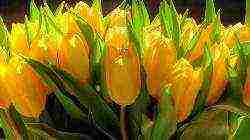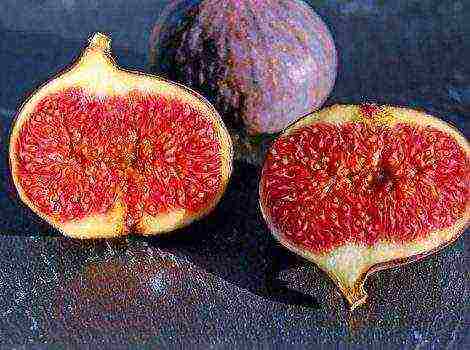Content
Rhubarb — (Rheum L.) Is the generic name of plants from family of buckwheat (Polygonacea). These are perennial, very large grasses that overwinter through thick, woody, branched rhizomes. Terrestrial stems are annual, straight, thick, floor and sometimes slightly furrowed.
The most common rhubarb varieties:
Large petiolate - early maturing, ready for harvesting after 35 days from petiole regrowth. It has a high shoot-forming ability, forming a compact rosette of medium-sized leaves. Leaves are dark green wavy, with a jagged edge. The petioles are large, juicy, dark crimson with pronounced pigment stripes. The length of the petioles is 50-60 cm, the width is 2.1-2.5 cm. The petioles contain a small amount of fiber, are distinguished by delicate sweet and sour pulp, high taste and technological qualities. Productivity - 1.9-2.5 kg / m2. The plant is resistant to fungal diseases. The formation of flower arrows is moderate.
Victoria Is an old popular variety. Plants have fast-growing large, up to 68 cm wide and up to 50 cm long, leaves with a wavy edge. The leaf petioles reach a length of 70 cm, at first they are dark red, then they turn light green with a pink base. The weight of one petiole is from 200 to 450 g. The variety is early ripening, fruitful, good taste.
Obsky - mid-season; petioles are ready for use after 65 days from the beginning of regrowth. The variety is cold-resistant, tolerates waterlogging well, does not tolerate drought. The petioles are large, 22-23 cm long, weighing 44-84 g, dark pink at the base, tender, contain little fiber. Productivity 2 kg / m2. Designed for the preparation of compotes, preserves.
Gigantic - late ripening, disease-resistant variety. Differs in high taste. The petioles are very long, fragile, dark red.
Moskovsky 42 - early maturing, fruitful variety, resistant to stemming. Leaves are smooth, large, with wavy edges. The petioles are thick and long (up to 55 cm), slightly ribbed, contain a small amount of fibers, red at the base, green at the top, with pale green flesh.
Ogre 13 - mid-season variety. Plant height up to 80 cm, compact rosette. The leaves are large, dark green. The petioles are large, dark red at the base, slightly ribbed, up to 70 cm long, 2–4 cm in diameter, some of them reach a mass of 300–350 g. Little flowering stems are formed. The petioles have high palatability. The variety forms few shoots and is resistant to shooting.
Beauty - mid-season rhubarb variety... The period from regrowth (in the second year of life after dividing the mother plants or in the third year after sowing the seeds) to the beginning of the economic shelf life of the petioles is 42 days. The plant is perennial. The rosette of leaves is semi-vertical. The leaf is medium-sized, ovoid, medium-bubbly, green, with a slightly wavy edge. The petiole is medium in length, red, the flesh is pink. The weight of the petiole is 150 g. The yield of the petioles is 2.5-3.5 kg / sq.m.
Candied - mid-season variety. The period from the beginning of regrowth to economic shelf life is 25 days. The plant is perennial. The height of the plant in technical ripeness is 50 cm, when the seeds ripen - 150 cm. The leaf rosette is vertical. The leaf is of medium length, green, bubbly, with a wavy edge. The petiole is of medium length, wide, red, the flesh is pink.The mass of one petiole is 200 g. The yield of petioles is 3.5 kg / sq.m. Cold-resistant, frost-resistant, responsive to watering, does not tolerate stagnant water.
Malachite - early maturing rhubarb variety... The period from spring regrowth to the beginning of the economic shelf life is 19 days. Perennial. The rosette of leaves is vertical. The leaf is medium-sized, green, slightly bubbly, slightly wavy, with five veins extending from the petiole, the shape of the top is obtuse, the base is overlapping. The petiole is long, of medium width and thickness, green, slightly ribbed, green flesh. The mass of one petiole is 200 g. The yield of petioles during the growing season is 3.6-12.8 kg / sq.m.
It is recommended to have 2 varieties, differing in terms of ripening (early and late) and in the quality of the petioles (green petioles for making puree and cabbage soup and red petioles for compotes).
A brief description of the varieties of rhubarb. What kind of rhubarb to choose.
Rhubarb contains useful nutrients, the plant is rich in various mineral salts (potassium, iron, phosphorus, calcium, magnesium). Rhubarb stalks taste like apples. Rhubarb is useful for its high content of vitamins C, P, A, B2 and especially malic and citric acids.
The advantages of planting rhubarb seeds is that you retain all the qualities of the acquired variety. And now there are many varieties of garden rhubarb, which differ in color, speed and time of development, the size of leaf petioles and leaves, taste and many other characteristics. Among the varieties of rhubarb offered today, the following can be noted:
A brief description of the varieties of rhubarb.
- Altai dawns - early ripening variety. From germination to the beginning of the collection of petioles, it takes 25-30 days. The rosette of leaves is highly spreading. The leaves are large, the petioles are long and red, weighing 80–120 g. The taste of the petioles is excellent.
- Victoria - early ripening, fruitful variety. Petioles up to 70 cm long, at first red, then they turn green, remaining dark only at the base. The average weight of petioles is 240-500 g. The length of the leaf blade is up to 60 cm, the width is 70 cm. It gives flower shoots in the second year, which must be pulled out, starting from the end of spring, preventing their rapid growth. The taste is high.
- Victoria improved - differs from the previous variety in larger petioles.
- Zaryanka - early ripening variety. It takes 30–35 days from germination to the first harvest. Spreading rosette of leaves. The petioles are from 30 to 45 cm long, have a beautiful bright color with cherry pigmentation, ripen together. The flesh of the stem is green-pink, sweet and sour.
- Early strawberry - early variety. Used primarily for forcing.
- Gigantic - late ripening, disease-resistant variety. Differs in high taste. The petioles are very long, fragile, dark red.
- Compote - early ripening variety (from the beginning of regrowth to the economic fitness of the petioles 33-35 days). The leaves are large, wide, slightly bubbly, with wavy edges, green. The petiole is large, thick, fleshy, green with a cherry color at the base, weighing 55-85 g. Shade-tolerant, but grows best in well-lit open areas.
- Red late 34- Petioles are bright red, weighing up to 160 g. The length of the leaf blade is 30-40 cm, the width is up to 40 cm. Flower shoots are formed late, in the 3-4th year. Good taste.
- Large petiolate - early ripening variety. Petioles up to 80 cm long and up to 2.5–3 cm thick. The petioles are dark red, the flesh is light green, sometimes with pink spots, sweet and sour. The variety is resistant to cold and disease. Good taste.
- Linnaeus - ultra early variety. Young leaf petioles are light green, smooth, completely flat from above, with rounded edges, fleshy, reaching considerable length. This variety is very valuable in terms of productivity for soil crops and for forcing.
- Monarch- mid-season variety.One of the most large-growing varieties, with smooth, very thick, fleshy, light green leaves rounded below, grooved on top. The leaf blades are very large, light gray-green. An excellent variety for bleaching in the summer, it is often also used for forcing.
- Moskovsky 42 - mid-season, high-yielding variety, resistant to stemming. The petioles are thick and long - up to 70 cm, slightly ribbed, contain a small amount of fibers, red at the base, green at the top, with pale green flesh. The leaves are smooth, large, with wavy edges. The length of the leaf blade is 40–55 cm, the width is 35–45 cm. The palatability is high.
- Obsky - mid-season variety with a large rosette of leaves up to 120 cm in diameter. The leaves are dark green, large, slightly corrugated, with long, thick, dark pink petioles at the base. The petioles are tender, sweet and sour, very beautiful in compotes. The variety is cold-resistant, tolerates excess moisture well, but does not tolerate drought well.
- Ogre 13 - mid-early grade. Plant height up to 80 cm, compact rosette. The leaves are large, dark green. The petioles are large, dark red at the base, gradually turn green above, slightly ribbed, 60–70 cm long, 2–4 cm in diameter, weight 150–350 g, some reach 600 g. Few flowering stems are formed. The pulp is slightly fibrous, tender, the taste of the petioles is high. The variety forms few shoots and is resistant to shooting.
- Paragon - mid-season variety. The leaf petioles are very fleshy and strong, largely similar to the Champagne variety, dark red, smooth, but strongly ribbed. Suitable for both open ground and forcing.
- Royal Albert - early variety. The leaf petioles are large, pale reddish at the beginning of development, later turning green (light green), smooth, round below, slightly grooved on top, slightly protruding ribs, sharp edges, light green leaf blades. This is one of the earliest varieties.
- Saint Martin - mid-season variety. It is very similar to the Linnaeus variety, from which it differs in the reddish coloration of leaf petioles and later growth.
- Setton- early variety. Very similar to the Victoria variety, but develops petioles earlier and much larger.
- Elephant red - early variety. One of the largest varieties, with red leaf stalks. Used primarily for forcing.
- Tukumsky 5 - mid-season variety. The leaves are large, dark green, with wavy edges. Petioles are rounded, up to 50 cm long, light green in color, with crimson pigmentation. The taste of the petioles is very high. The plant produces few shoots.
- Stubborn - early ripening variety. The rosette of leaves is high and rather spreading. Petioles are large, up to 55 cm long and weighing up to 150–180 g, light green with anthocyanin coloration at the base.
- Cyclone - mid-season variety. The bushes are very large and grow very quickly. Leaves are medium in size. The petioles are not thick, green in color.
- Candied - mid-season variety. Petioles are wide, large, weighing up to 200 g, red, with pink flesh, excellent taste.
- Champagne- ultra early variety. The leaf petioles are large, bright red, ribbed-wavy, of a pleasant sour taste, the petiole pulp is reddish. The leaf blades are large, dark green. A very early variety, especially suitable for forcing.
- Elford - early variety. One of the most suitable varieties for early forcing.
A brief description of the rhubarb varieties is given. And what variety you plant on your site is up to you. Good luck!
(Visited 322 times, 1 visits today)
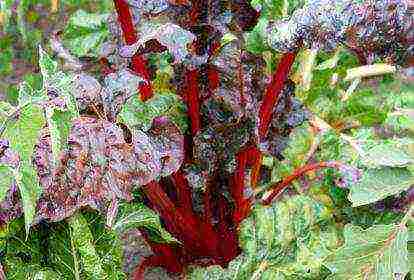
Thanks to significant selection work, many varieties of garden rhubarb have been introduced into the culture, differing in color and size of leaf petioles and leaves, speed and time of development, taste, suitability for early forcing and a number of other characteristics.
VICTORIA
Old English variety, early maturing, fruitful. It grows back quickly and early.The petioles are dark red at the base; above, they gradually turn green. The length of the petioles is up to 70 cm, weight is 240-500 g. The length of the leaf blade is up to 60 cm, width is 70 cm. It gives flower shoots in the second year. The taste is high.
VICTORIA IMPROVED
It differs from the previous variety in larger petioles,
MOSCOW 42
Mid-season, fruitful. Petioles at the base are red, above - green with red dots. The length of the leaf blade is 40–55 cm, the width is 35–45 cm. The length of the petioles is up to 70 cm. The palatability is high.
RED LATE 34
The petioles are bright red, weighing up to 160 g. The length of the leaf blade is 30-40 cm, the width is up to 40 cm. Flower shoots are formed late, in the 3-4th year. Good taste.
Coarse-cut
Early ripening, fruitful. The petioles are dark red, up to 80 cm long. The leaves are wavy. Good taste. Disease resistant.
OGRSKY 13
Medium early, fruitful, with good taste of the petioles. Resistant to stalking, in the 2-3rd year forms 1-2 flower shoots. The petioles are red at the base, gradually turn green above. The length of the petioles is 60–70 cm, the weight is 150–620 g; the pulp is slightly fibrous, tender.
ROYAL ALBERT
The leaf petioles are large, pale reddish at the beginning of development, later turning green (light green), smooth, round below, slightly grooved on top, slightly protruding ribs, sharp edges, light green leaf blades. This is one of the earliest varieties.
LINNEY
Young leaf petioles are light green, smooth, completely flat from above, with rounded edges, fleshy, reaching considerable length. This variety is very valuable in terms of productivity for soil crops and for forcing.
CHAMPAGNE
The leaf petioles are large, bright red, ribbed-wavy, of a pleasant sour taste, the petiole pulp is reddish. The leaf blades are large, dark green. A very early variety, especially suitable for bleaching and forcing.
SAINT MARTIN
It is very similar to the Linnaeus variety, from which it differs in the reddish coloration of leaf petioles and later growth.
ELFORD
One of the most suitable varieties for early forcing.
SETTON
Very similar to the Victoria variety, but develops petioles earlier and much larger.
MONARCH
One of the most large-growing varieties, with smooth, very thick, fleshy, light green leaves rounded below, grooved on top. The leaf blades are very large, light gray-green. An excellent variety for bleaching in the summer, it is often also used for forcing.
PARAGON
The leaf petioles are very fleshy and strong, largely similar to the Champagne variety, dark red, smooth, but strongly ribbed. Suitable for both open ground and forcing.
ELEPHANT RED
One of the largest varieties, with red leaf stalks. Used primarily for forcing.
STRAWBERRY EARLY
One of the earliest varieties. Used primarily for forcing.
All varieties of rhubarb can be combined into the following varietal groups:
Ultra-fast varieties: Linnaeus, Champagne.
Early varieties: Krupnochereshkovy, Moskovsky 42, Obsky, Zaryanka, Tukumsky 5, Stubborn, Strawberry early, Elephant red, Elford, Royal Albert, Setton.
Mid-season varieties: Ogre 13, Paragon, Monarch, Saint Martin.
Late varieties: Red late 34.
Table varieties: Victoria, Cyclops, Ogresky 13, Tukumsky 5.
Canning varieties: Zaryanka, Moskovsky 42, Krupnochereshkovy.
Previously, rhubarb was found in almost every garden area. Many people remember the wonderful delicious pies, jams, compotes, marshmallows, which they enjoyed in childhood. Since then, breeders have bred many new varieties that differ favorably from the old ones in growth rate, compact size, high content of vitamins, macro- and microelements. Rhubarb is one of the first vegetables to be harvested in the next season, it is not only tasty, but also very useful.He was forgotten completely undeservedly, and recently the lost popularity is beginning to return to him.
Feature and Description
Rhubarb (Rheum) is a genus of low herbaceous plants belonging to the Buckwheat family. It is quite numerous, in nature there are about 50 species. The birthplace of culture is China. There, its beneficial properties were known as early as 2500 BC. NS. The name of the plant comes from the Greek word, which means "gripping" in translation. It accurately describes the appearance of the outlet.
The plant was brought to Europe by travelers and pilgrim monks during the era of great geographical discoveries. At first, it successfully "took root" in the north of Germany and England, and from there it gradually spread throughout the continent. Russia (then the Russian Empire) learned about rhubarb much later, only at the end of the 19th century. The famous geographer N.M. Przhevalsky brought the seeds from his expedition to the Far East.

The homeland of rhubarb is central China; in Russia, certain varieties are found in the Far East and the Caucasus
Rhubarb is a frost-resistant crop that does not suffer from recurrent frosts. It tolerates a drop in temperature in spring to -10 ºС without the slightest damage. Growth buds begin to "wake up" when the air warms up to only 3–6 ºС. The plant feels best at 18–22 ºС. Rhubarb does not like heat - it practically stops growing, the petioles lose their juiciness, their pulp coarsens, tough fibers appear in it. All this makes the culture very suitable for growing in the Russian climate.
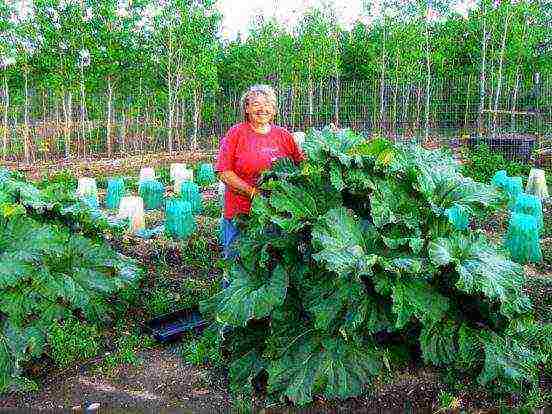
Most rhubarb varieties form powerful, spreading rosettes
The productive life of a rhubarb bush is 12–15 years. Leaves begin to form very early, almost immediately after the snow melts. This is due to the fact that the root system of the plant is powerful and developed. In the fleshy rhizome, a supply of nutrients accumulates, which rhubarb uses in the spring for growth. Fresh roots, like leaf plates, are inedible.
The leaves of rhubarb are ovoid or triangular in shape. They form a powerful socket with a diameter of over a meter. Most often they are whole, but there are also species with deeply dissected leaf plates, "corrugated" or "bubbly" surface, cut with teeth by the edge.
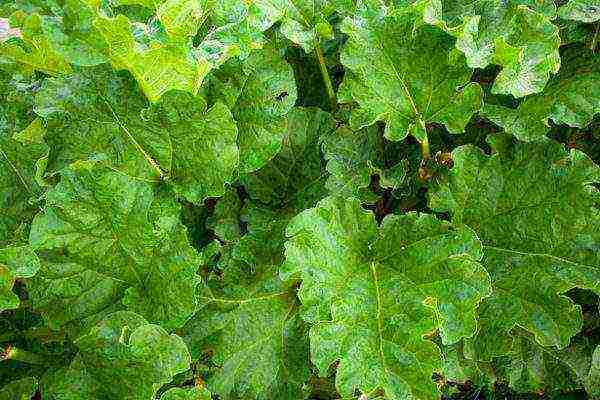
The shape of the leaf plate in different varieties of rhubarb is very different.
Their petioles are thick, about 70 cm long and 3-4 cm in diameter, and it is they who are eaten. Depending on the variety, they are colored pale green or purple-scarlet. The average yield per bush is 6–8 kg of petioles, but there are record-holder plants in which one petiole weighs about 1 kg. Rhubarb tastes like an apple. Gourmet gardeners appreciate rhubarb with red stalks more. It tastes less sour, more balanced.
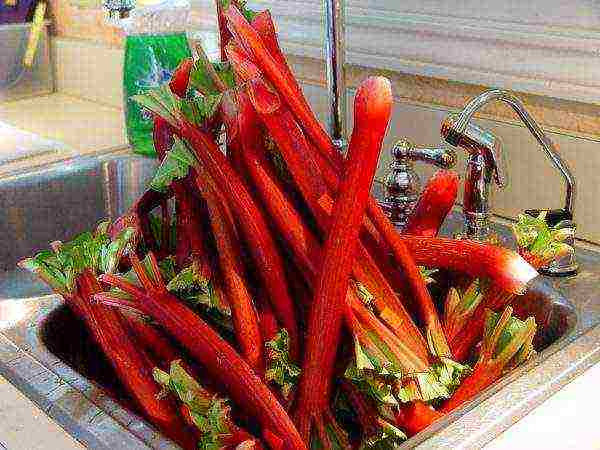
Rhubarb stalks are an excellent remedy for combating spring vitamin deficiency
The first time the crop is cut in the second year after planting in the ground. During the first season, the plant forms a root system, so it is not recommended to disturb it. Then the petioles are cut 3-4 times starting from the first decade of April for the next 2-2.5 months. Practice shows that the earlier the harvesting season ends, the more abundant it will be for the next year.
Rhubarb blooms violently. Peduncles covered with reddish “specks”, about 1–1.2 m high, rise above the rosette of leaves. The flowers themselves are small, greenish-white, collected in inflorescences in the form of drooping brushes or panicles. In decorative varieties of rhubarb, they can be colored in a yellowish, pinkish, crimson hue. If there is no goal to collect rhubarb seeds in the fall, it is recommended to cut the peduncle so as not to take away from the plant the forces necessary for the formation of fleshy petioles. Flowering occurs at the end of June or July, the brick-colored nuts ripen in the second decade of August.

Flowering takes a lot of strength from rhubarb, so it is recommended to remove the peduncle even at the stage of its formation.
In folk medicine, rhubarb has been used since time immemorial. A decoction from the roots normalizes the condition and activity of the gastrointestinal tract due to the presence in a high concentration of tannins, glycosides, organic acids.

Not only rhubarb stalks are useful, but also a decoction from its roots.
Petioles used for food are rich in vitamins and minerals, as well as pectin, organic acids (malic, citric, succinic), proteins. Rhubarb contains more vitamin C than apples. Potassium, phosphorus, iron and magnesium have a beneficial effect on the state of the cardiovascular system. Due to this, rhubarb has a good tonic effect, strengthens the immune system, helps cleanse the blood, and is useful for spring vitamin deficiency.
Rhubarb, like sorrel, is eaten only in the first half of the growing season, until about mid-July. When the leaves get old, malic acid is converted to oxalic acid. The latter in large doses is dangerous to the body, provoking calcium deposition. This can cause various joint problems, gallstones and urolithiasis. If a similar diagnosis has already been made, you should refrain from using rhubarb.
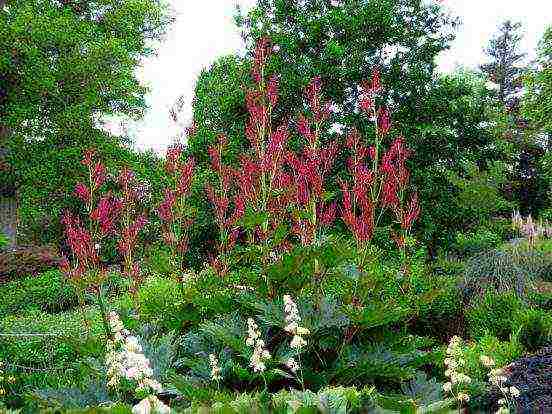
Ornamental rhubarb varieties, as a rule, are distinguished by an abundance of flowering.
Also, the accumulation of oxalic acid occurs during long-term storage of cut petioles, especially in warmth. Therefore, it is recommended to eat or process rhubarb immediately, and if it does not work out, rinse the petioles and put them in the refrigerator. But even in such conditions, the "shelf life" is no more than 7-10 days.
It is not difficult to recognize petioles that can still be eaten. Their leaves are not fully developed, the surface of the leaf plate is "corrugated". The petiole itself is convex, without a "groove" in the center. Its color should be even, without spots.
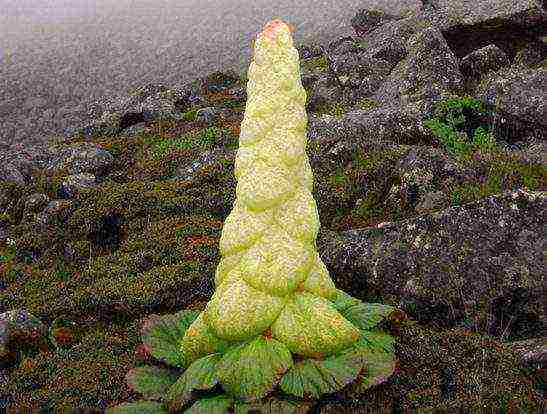
In many ornamental hybrids bred by breeders, it is difficult to recognize rhubarb.
Rhubarb is not only eaten fresh. It is widely used in cooking: jams, jams, jellies, marshmallows, marmalade, candied fruits, filling for pies, compotes, jelly are cooked from the stalks. It is also added to salads, main courses, soups, sauces to add a piquant sourness and even to ice cream. Special lovers of rhubarb substitute them for cabbage in cabbage soup and borscht, pickles in pickle, lemon in tea.

Rhubarb is widely used in cooking, both alone and in combination with a wide variety of foods.
When cooking, it is worth considering that rhubarb is cooked for a very short time, a maximum of 7-10 minutes. Then the petioles are boiled, turning into an unappetizing slimy porridge, and significantly lose their benefits.
Video: rhubarb and its health benefits
Which variety to choose
In Russia, until recently, rhubarb could not boast of particular popularity, so most varieties and hybrids are of foreign origin. But domestic breeders also have their own achievements. The most common varieties are:
- Altai dawns. Belongs to the category of early maturing. The petioles can be cut 27–32 days after the leaf buds wake up. The rosette is powerful, spreading, about 1.2 m in diameter. The petioles are long, rather thin, reddish. Average weight is about 100 g.
- Victoria. One of the most popular varieties in the world, time-tested. His homeland is Great Britain. Refers to the early. The length of the petiole is about 60 cm, weight is about 225 g. Some specimens grow up to 500 g or more. At first, they are painted in a deep purple color, then gradually change their shade to salad green. Only the very base of the petiole remains dark. In terms of taste, the variety is considered almost standard, new petioles are formed very quickly. The bush often forms flower stalks, this should be monitored from mid-May. There is also a "clone" of this variety - Improved Victoria.It practically does not differ from the "parent", only the petioles are slightly larger.
- Zaryanka. The crop ripens in 32–36 days. The petioles are about 40 cm long, painted in a rich cherry color. Their flesh is greenish-pink. Rhubarb blanks of this variety are not only very tasty, but also attractive in appearance.
- Gigantic. Late variety, petioles are formed within 50 days. It is appreciated for its high immunity. The petioles are more than 70 cm long, but they are very fragile. The taste is balanced, sweet and sour.
- Large petiolate. Early ripening variety. The name fully justifies. The length of the petiole is about 70 cm, the diameter is 3–3.5 cm. The lower part of it is colored crimson-crimson, above it changes color to green with pinkish spots.
- Obsky. The rosette of leaves is large, more than 1.5 m in diameter. Leaves of a deep dark green color, slightly corrugated. Petioles are salad, pinkish at the base. The pulp is very tender. This variety is frost-resistant, does not pay attention to too abundant watering, but is very sensitive to drought.
- Ogre-13. A variety of medium ripening. The rosette is quite compact, 75–80 cm in diameter and about the same height. Petioles up to 60 cm long and 3-4 cm in diameter, each weighing 300 g or more. At the base, they are colored dark scarlet. The bush practically does not form peduncles.
- Cyclone. The variety is of medium ripening, differs in growth rate. Spreading rosettes, more than 1.5 m in diameter. Petioles are rather thin, pale green. Each weighs an average of 200 g.
- Compote. The variety is medium early, the petioles can be cut 35–37 days after germination in spring. The leaves are dark green, the surface is slightly bubbly, the edges are corrugated. The petioles are thick and juicy, but not large, weighing 70–90 g. The bush can be planted even in the shade.
- Red late-34. It got its name thanks to its deep-scarlet petioles. They have very good taste, the average weight is about 150 g. The rosette is compact, the leaves are not large (up to 35 cm long). They shine glossy and shine purple. The first peduncles are formed only 3-4 years after planting. Differs in almost a record content of vitamins and minerals.
- Monarch. One of the most powerful and spreading rosettes, reaching 2 m in diameter. The leaf plates are smooth, more than 80 cm long, pale green with a gray-gray tint. Petioles are greenish, slightly ribbed to the touch. The average weight of each is up to 400 g, the length is about 80 cm.
- Paragon. A variety of medium ripening. The petioles are very juicy and strong, beetroot-colored, glossy shiny. They are smooth to the touch, with pronounced ribs. The rosette is quite compact, about 70 cm in diameter. This variety can even be grown at home.
- Royal Albert. Another British variety, one of the earliest. The leaves are pale green, with a pointed tip. The newly formed petioles are colored light red; gradually it changes to salad. The average weight is about 350 g, the length is up to 60 cm. The petioles are smooth, rounded to the touch, the ribs are almost invisible.
- Tukumsky-5. A variety of medium ripening. The leaves are very large, with corrugated edges. The petiole is about 50 cm long and 2–3 cm thick. They are painted in a light green color with vague spots of different shades of pink. The taste is excellent. Peduncles are relatively rare.
- Stubborn. Early variety. Forms a rosette up to 1.2 m high and about 1.5 times in diameter. The length of the petiole is about 50 cm, the average weight is 175 g. They are painted in a pale green color, which changes to inky purple at the base.
- Champagne. The variety belongs to the category of ultra-early, most often used for spring forcing. The rosette is not too spreading, but the leaves are large, up to 80 cm long. The petioles are fleshy, thick, 55–60 cm long, often slightly curved. They are painted in a rich scarlet color, the flesh is reddish, and the taste is sour.Homemade preparations from this variety of rhubarb are painted in a beautiful pale pink color. The ribs are well felt in the petioles to the touch.
- Bowles Crimson. Often planted not only for the sake of the harvest, but also to decorate the garden plot. Its outlet is compact, in the shape of a bowl. The reverse side of the smooth sheet is bright scarlet, the front side is purple. The bloom is very abundant, depending on the growing conditions, the flowers are colored in different tones - from pale pink to dark purple.
- Candied. It is prized primarily for its taste and the large size of the petioles weighing about 250 g. They are painted in a bright crimson color, the flesh is pale pink. Rosette up to 1 m high and approximately the same diameter.
Photo gallery: popular varieties of rhubarb
Altai Dawns rhubarb belongs to the category of early varieties Victoria - an "old well-deserved" variety, popular all over the world Thanks to the shade of the pulp, the preparations from the Zaryanka rhubarb are not only tasty, but also very presentable. only for the size of the petioles, but also for their taste.With a moisture deficit, the yield of the Obsky variety sharply decreases Rhubarb of the Ogrsky-13 variety is suitable even for growing in very small garden plots - this is due to the compactness of the rosette. successfully adapts and yields a harvest even in the shade, but still it is impossible to call it a shade-loving crop Variety Red p Ozdny-34 not only brings a bountiful harvest, it also decorates the garden. Tukumsky-5, in comparison with other varieties, is not prone to flowering Rhubarb Stubborn - one of the latest achievements of Russian breeders The harvest of rhubarb of the Champagne variety is one of the first to be removed Many ornamental rhubarb varieties, including Bowles Crimson, are successfully used in landscape design Rhubarb of the Candied variety - these are large petioles and excellent taste
Planting procedure and preparation for it
Rhubarb is an unpretentious plant, therefore, a place in a garden plot is most often assigned to it "on a residual principle." The plant is undemanding to the quality of the soil, but the maximum possible yield can be collected only on fertile soils with good aeration. The best option is light loam.
The culture tolerates partial shade well, direct sunlight and heat are even harmful for it. Therefore, rhubarb can be planted in the trunk circle of any fruit trees. They receive water and food from different soil layers, respectively, they are not competitors for each other. If the rhubarb bushes do not grow too densely, any herbs can be planted between them. This helps to save space in the garden, and the pungent smell repels many pests.
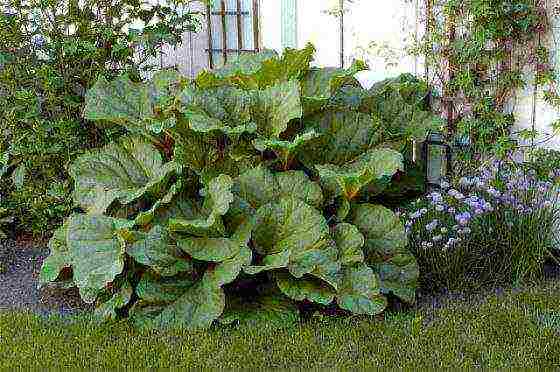
Rhubarb prefers light partial shade, being in direct sunlight is harmful for it
But rhubarb has a very negative attitude to the stagnation of water at the roots: root rot develops almost inevitably. Therefore, any lowlands are categorically not suitable for him, where melt and rain water accumulates, moist cold air stagnates.
Rhubarb takes root well in the beds, where any cabbage, beans, spinach, spicy aromatic herbs grew before. He does not like many cultures, hardly tolerating the neighborhood with them. First of all, these are peas and beans. Also, rhubarb does not get along well with any Solanaceae, onions, carrots, radishes.
Landing
The soil in the planting hole must be well fertilized so that the plant has enough nutrients to form a root system. It is always prepared in advance, at least a couple of weeks before disembarkation.Pits are not made too deep, about 50 cm is enough with the same diameter. Since the rosettes of most varieties are powerful and spreading, at least 1.5 m is left between neighboring bushes.
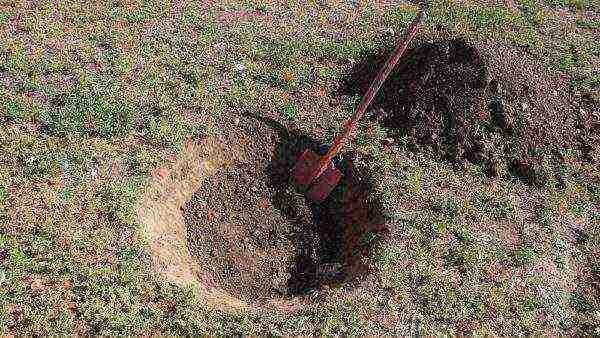
A planting pit for rhubarb is always prepared in advance.
The pit is filled with a mixture of humus or rotted compost with fertile soil (8-10 l each) and coarse river sand (2-3 l). From fertilizers add 30-50 g of superphosphate and potassium sulfate or a liter can of wood ash. If the acidity of the soil differs from neutral, add dolomite flour or ground eggshells (250-400 g).

For planting rhubarb, the soil, if necessary, is deoxidized with dolomite flour or fluff lime
Most often, rhubarb is planted as seedlings, especially in temperate climates. The seeds can be purchased at the store without any problems or collected by yourself. They are fully ripe when they get enough sleep even from a light touch of the panicle inflorescence.
For planting seedlings in the ground, choose a cloudy, cool day. They act like this:
- Plants are removed from the container along with a lump of earth or planted in a garden bed directly with a pot, if it is peat. Previously, the soil in the planting pit must be well loosened and watered.
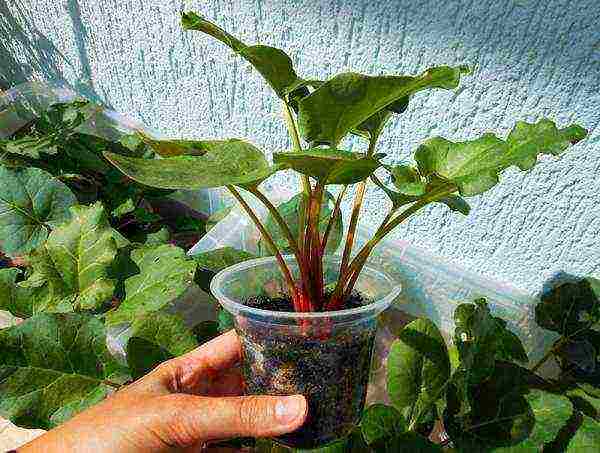
Rhubarb seedlings are planted in the ground 3–3.5 months after germination
- When planting, rhubarb seedlings are buried as deeply as possible so that after abundant irrigation (8–10 liters of water), the root collar remains 5–6 cm underground. This is necessary, because every year the powerful rhubarb rhizomes bulge noticeably when the snow thaws.
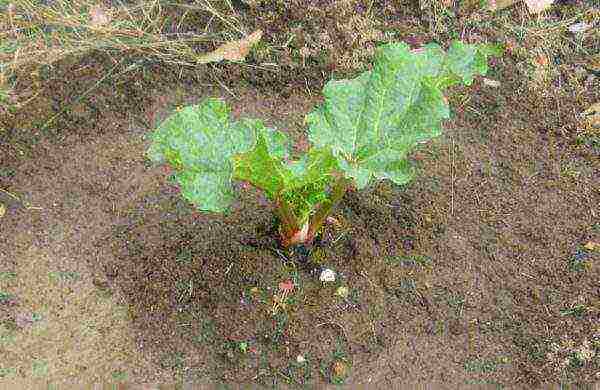
When planting rhubarb, be sure to deepen the root collar
- After planting, the soil is carefully compacted, covered with a layer of mulch (peat, humus) 3-4 cm thick.
You can plant rhubarb directly in the garden with seeds. But this method is practiced relatively rarely. They do not differ in germination (even with preliminary preparation), regardless of whether the procedure is carried out in autumn or spring. In the first case, the seeds are sown densely in grooves 2-3 cm deep in mid-October, in the second - in early April or even in March. The frost resistance of rhubarb allows it.
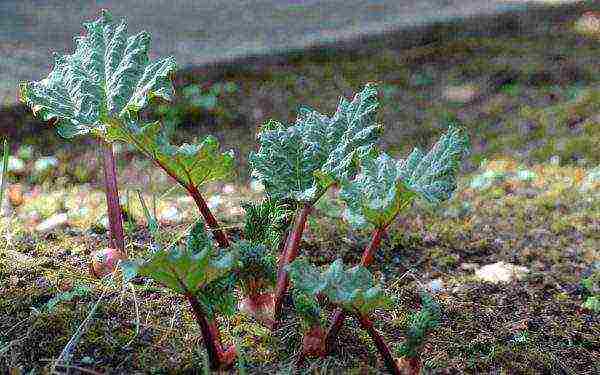
Planting rhubarb seeds directly into the garden is rarely practiced.
It is advisable to choose a place for rhubarb immediately and forever. Adult plants do not tolerate transplantation very well due to the presence of powerful developed roots. It is almost impossible to dig a bush out of the ground so that the rhizome does not suffer. And transferring the resulting earthen lump to a new place, most likely, will not work out purely physically. Even if it turned out to carry out a transplant, the bush will move away from the "stress" within 2-3 years.
Plant care
Rhubarb often grows and yields a harvest every year without any maintenance. But you must not completely forget about him. It is enough to devote a little time to it, watering, adding fertilizers, weeding and loosening the beds. Nothing supernatural is required from the gardener, but these agrotechnical measures have a positive effect on the yield, juiciness and taste of the petioles.
Rhubarb bushes are quite difficult to weed due to the spreading rosettes of leaves, so you need to constantly renew the mulch layer. This will save you time and effort in weeding. Mulch also retains moisture in the soil, and this is very important for rhubarb, since it does not tolerate heat and drought very well.
Top dressing
In the first year after planting, rhubarb is fertilized every 1.5–2 weeks. It is advisable to use natural organic matter - infusions of fresh cow dung, bird droppings, nettle and dandelion leaves. They are prepared for 2-3 days, before use they are diluted with water in a ratio of 1:10 or 1:15 (if dung was used as raw material). Organic fertilizers can be alternated with mineral fertilizers, using liquid complex products - Kemira-Universal, Master, Zdraven, Good Strength, and so on.
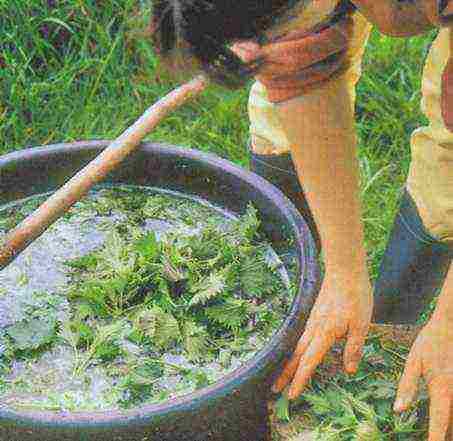
Nettle infusion is a natural source of nutrients that rhubarb needs for normal development
Rhubarb is distinguished by its growth rate, therefore, it is very much in need of nitrogen. In the second season, before the beginning of the active growing season, ammonium nitrate, ammonium sulfate, urea (10-15 g / m²) are introduced into the near-trunk circle. Once every 2-3 years, you can add humus and rotted compost to the roots or add humus to the aisles.
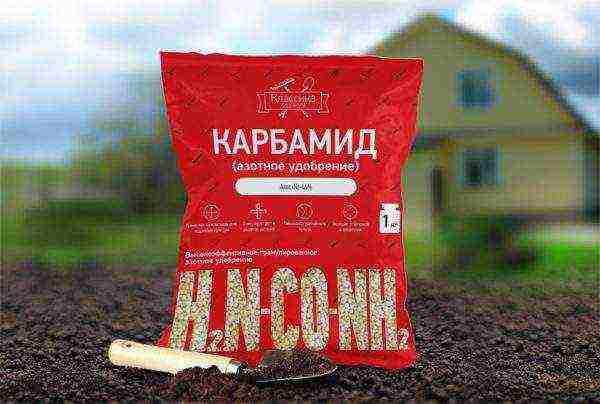
Urea, like other nitrogen-containing fertilizers, stimulates the plant to intensively build up green mass, but it is important not to overdo it with it.
The second feeding is carried out after 20-25 days. Prepare the same infusion as for young plants, adding 20 g of simple superphosphate and potassium sulfate per 10 liters. The last time the plants are fertilized in the second decade of August, using complex agents containing potassium and phosphorus (ABA, Autumn) or an infusion of wood ash.
Nitrogen fertilizers are applied exclusively in spring. Further feeding provokes rhubarb flowering, nitrates accumulate in the petioles.
Watering
Without regular watering, obtaining a bountiful harvest of rhubarb is impossible. During the growing season, it is carried out 3-4 times, consuming 40-50 liters of water per 1 m². Bushes that have enough moisture will accumulate less oxalic acid in the stalks. And with a shortage of water, the pulp coarsens, fibers appear in it.
Each time after watering, after about half an hour, the soil in the aisles is loosened, if necessary, a layer of mulch is renewed. In extreme heat in the absence of rain for a long time, it is advisable to spray the leaves in the early morning or evening after sunset (it is better to do this twice a day). Their area is large, so the plant quickly loses moisture.
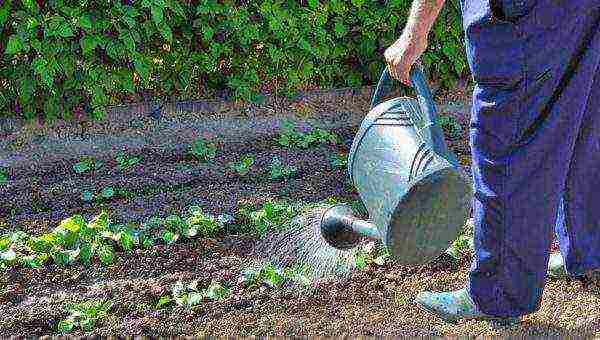
Regular watering is important for young rhubarb plants, adults can easily get by with natural precipitation and moisture from the soil
Preparing for winter
Rhubarb does not need a special shelter for the winter. Young plants can be sprinkled with straw, sawdust or fallen leaves. By autumn, the bush, as a rule, is overgrown with leaves again. About a third of them need to be cut off so that the plant can store enough nutrients for wintering.
Harvest by cutting the petioles very carefully so as not to damage the growing point. Better even to break them out. The petiole is slightly turned in both directions, then pulled sharply down. You cannot pull up, so as not to damage the rhizome. At least 2-3 leaves are left in each outlet so that the plant can feed properly.
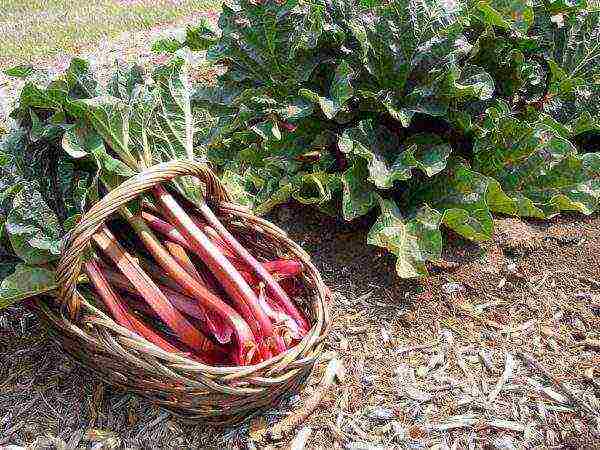
Rhubarb is harvested so as not to damage the roots and growth points in the process.
Rhubarb is not distinguished by a strong tendency to branching. However, so-called uterine stems sometimes appear. They are cut off immediately so as not to weaken the bush.
Video: care recommendations
Culture propagation methods
Rhubarb reproduces both generatively and vegetatively. The first is used less often - the seeds do not differ in germination, the preservation of the varietal characteristics of the "parent" is not guaranteed (this is especially true for ornamental varieties).
Dividing the bush
This method allows you to quickly get a new rhubarb bush. It is also often used to rejuvenate a bush or if rhubarb needs to be moved to a new location. Depending on the size of the bush, 5-8 new ones are obtained from one old outlet.
The procedure is carried out in spring or autumn. The second option is preferable - if you do everything necessary at the beginning of September, the plant will have time to recover from the stress before the first frost, and the next year it will already yield a harvest of thin petioles. But still, it is better not to cut them off, allowing the outlet to get stronger enough.
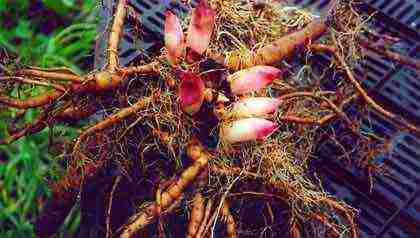
Dividing a rhubarb rosette is no different from a similar procedure for other horticultural crops
Only absolutely healthy bushes at the age of five years are suitable for division. The rhizome is carefully dug up and divided with a sharply sharpened disinfected knife so that each part has at least one “eye”. You cannot use a shovel for this - large taproots and growth buds are often damaged.
Sections are sprinkled with crushed chalk, sifted wood ash, colloidal sulfur, cinnamon. Then parts of the bush are dried in the sun for 2-3 hours and immediately planted in the chosen place.
During the week, new bushes are watered moderately daily. If the weather is sunny, a canopy is erected over them from any white covering material to protect from direct sunlight.
Germinating seeds
There is nothing difficult in growing rhubarb seedlings.
- 3-4 days before the expected planting, the seeds are immersed in water heated to room temperature for 10-12 hours so that they swell well. Those that float to the surface can be thrown away immediately: they are guaranteed not to sprout. Then for an hour for disinfection they are kept in a pale pink solution of potassium permanganate.
- The processed seeds are wrapped in a napkin or gauze soaked in warm water with the addition of a few drops of any biostimulant, and placed in a saucer, which is placed on a battery. The fabric must be kept slightly damp at all times to prevent it from drying out.
- When the seeds hatch, they are dried for 8-10 hours and planted in small peat pots or plastic cups of 3-5 pieces, deepening no more than 2-3 cm. Fill the containers with any universal substrate for seedlings. A 1: 1 mixture of humus and sand is also suitable. To prevent the development of diseases, you can add a tablespoon of crushed chalk or sifted wood ash for every liter of soil.
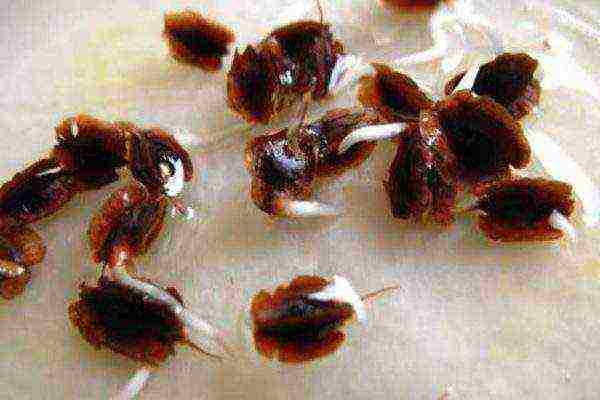
Preliminary preparation before planting for rhubarb seeds is required, they cannot boast of high germination
- Until emergence (usually it takes 15–20 days), the containers are covered with plastic wrap or glass, kept in a dark, warm place. The substrate is regularly moistened with a spray bottle, constantly keeping it in a moderately moist state. As soon as the seeds germinate, the "greenhouse" is removed, the container is moved to the brightest place in the apartment. A sill of a window facing south or southeast will work well. The temperature is kept at the level of 20-22 ºС so that the seedlings do not stretch too much.
- During the summer, seedlings are regularly watered, once every 10-12 days they are fed with a solution of any complex liquid fertilizer for seedlings (Rostock, Ideal). Rhubarb is ready for planting in the ground in 3–3.5 months after germination, by the end of August or by the beginning of September. Usually by this time the seedling grows up to 25-30 cm and has 3-4 true leaves.
You can plant rhubarb seeds for seedlings in both spring and autumn. In the first case, they are kept in the refrigerator during the winter in a container with wet sand or peat. The harvest from seedlings will have to wait at least three years.
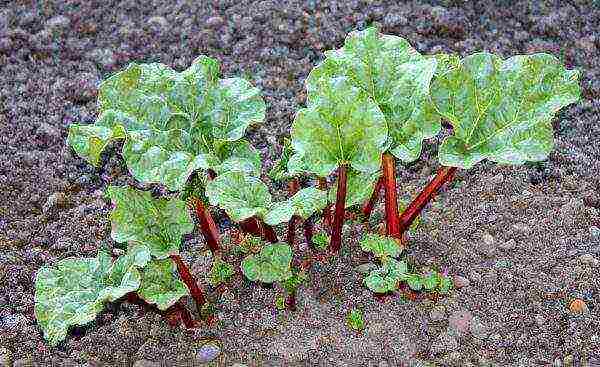
Rhubarb seedlings will have to wait long enough, and the seedlings harvest even longer.
Video: how to grow rhubarb seedlings
Diseases, pests and control of them
Rhubarb by nature has good immunity, but it is not immune from attacks of diseases and pests, especially if even minimal planting care is absent. Therefore, the condition of the outlets should be monitored regularly and measures should be taken immediately after the detection of suspicious symptoms.
Of the pests for the culture, the most dangerous are:
- Rhubarb weevil. Small bugs feed on the leaves of the plant, the larvae eat out the growth buds and petioles from the inside. For prophylaxis, the soil in the near-trunk circle is treated with Phosphamide, Aktellik, Corsair before the beginning of the active growing season. The procedure is repeated 2-3 weeks after the entire crop has been harvested. Having found a pest, the leaves are sprayed with biological products Iskra, Askarin, Fitoverm. Folk remedies - infusion of hot pepper, mustard powder, tobacco crumbs.
- Cabbage and potato scoop. The larvae, laid by small grayish-brown butterflies, eat up the leaves, leaving only veins, eat out the petioles and rhizomes from the inside.Adults from planting rhubarb are discouraged by infusions of tomato or wormwood tops, Lepidocid and Bitoxibacillin preparations. Spraying is carried out every 5-7 days. For prevention, rhubarb and soil in the trunk circle in mid-spring are treated with Agravertine solution. Inta-Vir, Zeta, Fury, Karate are used to combat the pest.
- Buckwheat (or beet) flea. Small jumping bugs, the shell of which casts golden or bronze, eat out the inner tissues of the leaf. As a result, translucent "tunnels" appear on them, sometimes bordered in red. For prevention in early spring, the soil in the garden is sprinkled with tobacco dust or hot pepper. Particular attention should be paid to weeding. To destroy the pest, they use BI-58, Kinmiks, Bazudin. Chemical treatments are carried out only after the crop has been harvested.
- Sorrel leaf beetle. Bluish-green shiny beetles eat away young leaves and petioles from the inside, leaving long longitudinal passages. On the outside, they look like scars. Gradually, the fabrics in these sheets break through, the sheet now looks more like lace. For the prevention and control of the pest, rhubarb should be regularly sprayed with infusion of onion or garlic gruel, chamomile, or powdered with tobacco dust, ground red pepper. When bugs appear, manual collection is practiced. The use of chemicals is undesirable. The period of the greatest activity of the leaf beetle falls just at the time of collecting the petioles.
- Onion nematode. Small thin worms eat up the stems and rhizomes from the inside, lay eggs on them. The roots are covered with rounded growths, rhubarb practically stops growing. For prevention, in early spring and autumn, the garden bed is sprayed with a solution of Karbofos or Chlorophos. When suspicious signs appear, sprinkle with hot (45-50 ºС) water 2-3 times.
Photo gallery: pests dangerous for rhubarb
The main reason for the development of diseases is care errors. Most often, this is "to blame" for improper watering or feeding with excessive nitrogen content. The situation is aggravated by cold rainy weather. Do not forget about the fight against harmful insects, many of which carry pathogens.
Rhubarb can be affected by the following diseases:
- Root rot. The rosette stops growing, the leaves go numb. The bases of the petioles turn black. Mold appears on the soil, an unpleasant putrid smell comes from it. For prevention, the garden bed is spilled in early spring with a 1% solution of copper sulfate, rhubarb is sprinkled with wood ash. The disease can only be treated at an early stage of development. All the affected parts of the plant are cut off with a sharply sharpened disinfected knife, the "wounds" are sprinkled with crushed activated carbon and chalk. Water for irrigation is replaced with a pale pink solution of potassium permanganate. The leaves are sprayed with a solution of Horus, Topaz, Fitoverm 2-3 times with an interval of 5-7 days.
- Gray rot. Leaves and petioles are covered with a "fluffy" white-gray bloom with small black blotches. The tissues in these areas become unpleasantly slimy to the touch. Prevention and control measures are the same as for root rot.
- Ramulariasis. Small rounded dark brown spots with a reddish border appear on the petioles and leaves. Gradually they turn pale and "blur", their surface cracks, overgrown with a grayish bloom, the leaves dry up. For prevention in early spring, rhubarb and a garden bed are sprayed with a 2% solution of Bordeaux liquid or copper sulfate. These same drugs help in the early stages of the development of the disease. If it is started, all that remains is to dig up and burn the bush, spilling the soil in this place with a bright pink solution of potassium permanganate.
- Powdery mildew. Leaves and petioles are covered with a "loose" whitish bloom, which gradually thickens and darkens. Tissues blacken and die, holes appear. For prevention, rhubarb is powdered with sifted wood ash or colloidal sulfur. To combat the disease, Alirin-B, Gamair, Planriz are used.
- Rust.The reverse side of the leaf is covered with spots of a bright yellow-orange "fleecy" plaque. On the front side, bulges form in these places. Prevention is the same as for powdery mildew. To combat rust, drugs Topaz, Skor, Strobi are used. Usually 2-3 treatments are sufficient with an interval of 10-12 days. You must first cut off all infected leaves.
Photo gallery: rhubarb diseases
Reviews of gardeners
Growing rhubarb is within the power of even a novice gardener. It is extremely unpretentious, but at the same time it is very tasty and healthy. Also, this crop is distinguished by high yields and early ripening periods. The stalks can be cut several times during the growing season, constantly providing themselves with the necessary vitamins and minerals.
27 years old, higher education in law, broad outlook and interest in a variety of topics.

